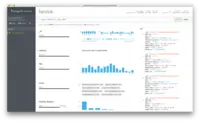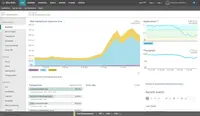Overview
What is MongoDB?
MongoDB is an open source document-oriented database system. It is part of the NoSQL family of database systems. Instead of storing data in tables as is done in a "classical" relational database, MongoDB stores structured data as JSON-like documents with…
Why is MongoDB good
MongoDB - A Stellar NoSQL Database
Perfect No SQL DB is here
The best no-sql DB to work with and to start in documented db world
Oleg's MongoDB review
Want to gain insights from unstructured data? This is the tool that everyone should use.
MongoDB by a front-end guy
No data relations, go MongoDB!
Stable & Easy to Use
No relation, no worry
MongoDB is the way to go!
One of the best nosql databases for web applications
MongoDB: King of NoSQL
MongoDB, a flexible/reliable DB that will draw you to the NoSQL world.
MongoDB, The ideal database for your projects in full JavaScript
Awards
Products that are considered exceptional by their customers based on a variety of criteria win TrustRadius awards. Learn more about the types of TrustRadius awards to make the best purchase decision. More about TrustRadius Awards
Popular Features
- Availability (38)9.797%
- Performance (38)9.090%
- Concurrency (38)8.686%
- Security (38)8.686%
Pricing
Shared
$0
Serverless
$0.10million reads
Dedicated
$57
Entry-level set up fee?
- No setup fee
Offerings
- Free Trial
- Free/Freemium Version
- Premium Consulting/Integration Services
Starting price (does not include set up fee)
- $0.10 million reads
Product Demos
MongoDB Change Streams: The Hidden Gem within the MongoDB Repertoire
MongoDB & Tableau FAA Demo
NoSQLMap MongoDB Management Attack Demo
Intro to MongoDB with C# - Learn what NoSQL is, why it is different than SQL and how to use it in C#
MongoDB with Python Crash Course - Tutorial for Beginners
Features
NoSQL Databases
NoSQL databases are designed to be used across large distrusted systems. They are notably much more scalable and much faster and handling very large data loads than traditional relational databases.
- 9Performance(38) Ratings
How fast the database performs under data load
- 9.7Availability(38) Ratings
Availability is the probability that the NoSQL database will be available to preform its function when called upon.
- 8.6Concurrency(38) Ratings
Concurrency is the ability for multiple processes to access or change shared data simultaneously. The greater the number of concurrent user processes that can execute without blocking each other, the greater the concurrency of the database system.
- 8.6Security(38) Ratings
Security features include authentication against external security mechanisms liker LDAP, Windows Active Directory, and authorization or privilege management. Some NoSQL databases also support encryption.
- 9.4Scalability(38) Ratings
NoSQL databases are inherently more stable than relational databases and have built-in support for replication and partitioning of data to support scalability.
- 9.1Data model flexibility(38) Ratings
NoSQL databases do not rely on rely on tables, columns, rows, or schemas to organize and retrieve data, but use use more flexible data models to accommodate the large volume and variety of data being generated by modern applications.
- 9.1Deployment model flexibility(37) Ratings
Can be deployed on-premise or in the cloud.
Product Details
- About
- Integrations
- Competitors
- Tech Details
- FAQs
What is MongoDB?
MongoDB's flagship Enterprise Advanced edition is a collection of products and services that drive security, efficiency, to put users in control of MongoDB Databases. These include:
- MongoDB Enterprise Server - the commercial edition of MongoDB, which includes additional capabilities such as in-memory storage engine for high throughput and low latency, advanced security features like LDAP and Kerberos access controls, and encryption for data at rest. Enterprise Server is included with the MongoDB Enterprise Advanced subscription, which includes expert assistance and tools. Or, the MongoDB Enterprise Server is also available free of charge for evaluation and development purposes.
- MongoDB Ops Manager - Tools for managing MongoDB in a secure, on-premise or owned environment. Available through the MongoDB Enterprise Advanced subscription, Ops Manager eliminates operational overhead by automating key administration tasks such as deployment, and upgrades. Tools also support monitoring with visualization of performance metrics, continuous or point-in-time incremental backup, and query optimization with the Visual Query Profiler.
- MongoDB Enterprise Kubernetes Operator - Kubernetes Operators are application-specific controllers that extend the Kubernetes API to create, configure, and manage instances of stateful applications such as databases. On self-managed infrastructure – whether on-premises or in the cloud – Kubernetes users can use the MongoDB Enterprise Operator for Kubernetes and MongoDB Ops Manager or Cloud Manager to automate and manage MongoDB clusters.
MongoDB is available as a managed cloud solution via MongoDB Atlas. But MongoDB Enterprise Advanced offers advanced access control and data security features to protect on-premise or private cloud databases, and satisfy compliance or customer requirements. It’s also designed to make it easy to integrate MongoDB with any existing security infrastructure and tooling.
Organizations from startups to the largest companies can use MongoDB's capabilities to create applications never before possible at a fraction of the cost of some legacy databases. The MongoDB database ecosystem boasts over 10 million downloads, thousands of customers, and over 1,000 technology and service partners.
Also, the MongoDB Community Edition is licensed under what the company provides as the Server Side Public License (SSPL), which is based on the GPL v3. All MongoDB Community Server patch releases and versions released on or after October 16, 2018, will be subject to this new license, including future patch releases of older versions. The Community version of the distributed database offers a document data model along with support for ad-hoc queries, secondary indexing , and real-time aggregations to provide ways to access and analyze data.
MongoDB Features
- Supported: Comprehensive monitoring for full-performance visibility
- Supported: Automated database management for 10-20x more efficient ops
- Supported: Fully-managed backup for peace of mind
MongoDB Screenshots
MongoDB Video
MongoDB Integrations
MongoDB Competitors
MongoDB Technical Details
| Deployment Types | Software as a Service (SaaS), Cloud, or Web-Based |
|---|---|
| Operating Systems | Unspecified |
| Mobile Application | No |
Frequently Asked Questions
Comparisons
Compare with
Reviews and Ratings
(432)Community Insights
- Business Problems Solved
- Recommendations
MongoDB has emerged as a popular choice for developers and organizations seeking a fast and efficient NoSQL data layer for their web applications. Its flexibility and iterative development capabilities have made it invaluable in various use cases. For example, MongoDB is being utilized by engineering departments to power SaaS platforms, allowing clients to create and configure assets for account-based marketing efforts. The document store of MongoDB proves ideal for handling complex configurations with nested structures. Additionally, the native JSON support is convenient and valuable when working with data needed in web browsers. MongoDB's aggregation framework enables the generation of complex reports and dashboard reports, which are immensely beneficial for businesses. The replication feature of MongoDB seamlessly allows applications to scale and support numerous clients, further enhancing its utility.
Furthermore, MongoDB has proven its worth as a temporary mid-size storage database for processing massive amounts of data per day and extracting notable events and records for further analysis. It facilitates quick application development in the cloud, enabling free usage and evaluation of system loads. Additionally, MongoDB serves as an internal database type in REST APIs for high-load applications. Compared to traditional SQL systems, MongoDB stands out due to its scalability and superior performance in terms of reads and writes. Its simplicity and clarity make it a preferred choice when dealing with large amounts of data. Furthermore, MongoDB is extensively used as the main storage technology for web development projects employing the MEAN Stack. Its scalability and unstructured document storage are particularly valued from a business perspective.
Moreover, MongoDB's non-relational nature simplifies database modeling and optimizes performance when working with JavaScript or JSON objects. It has been recognized for optimizing delivery time, making projects more feasible within specified timelines. MongoDB is widely employed as the main persistent datastore for SaaS offerings, providing robust and scalable solutions. It finds immense utility in large-scale, high-transaction environments as well by storing analytics information from social networking sites or serving as the primary datastore for Intranets. Additionally, MongoDB handles data with hundreds of variances effectively, which can be challenging to manage in a relational database. Its lightweight alternative for front-end-heavy projects and document-based data storage makes it a compelling choice over traditional RDBMS solutions. Consequently, MongoDB proves useful for managing a large amount of information, making it a preferred choice for banks and large institutions.
Moreover, MongoDB's application extends to various domains such as train yard management applications, where it enables easy management of JSON structures within a database. Gradually, MongoDB is being adopted by different teams and products after resolving scaling and sharding issues. It is highly regarded by software development teams for its efficiency, easy learning curve, and efficient query languages. MongoDB bridges the gap between data analysis and developers by facilitating the structuring of databases and primary querying. Consequently, organizations across industries utilize MongoDB for developing internal applications as well as apps for other companies.
MongoDB's robustness and scalability make it suitable for handling millions of unstructured records, such as defect management in software projects. It excels at building multiple dashboards and metrics from data using simple find queries, aggregation, and MapReduce operations. MongoDB also serves as a reliable storage solution for handling intense database use cases, storing critical customer information, rules, configuration data, and content for alert notifications and statements.
The horizontal scale-out capabilities of MongoDB coupled with its ability to work with complex structures of information make it a chosen technology for many applications. Its ease of use during the initial stages of a project and its ability to handle data increase quickly are additional reasons why programmers favor MongoDB. It is commonly used as a store of user accounts and app settings for mobile apps implemented in JavaScript and Node.js.
Furthermore, MongoDB helps improve response times by scaling systems horizontally and distributing the load effectively. It supports agile methodology software development life cycles with its dynamic schemas, which facilitate iterative development and rapid prototyping. Developers appreciate MongoDB as an efficient NoSQL database that offers scalability coupled with good support and helpful documentation.
Additionally, MongoDB solves performance problems in APIs by providing an easy-to-scale solution while enabling developers to work in an agile manner and improve response time. Its ability to store non-relational data like user profiles and application logs makes it a popular choice among developers who need to work with diverse datasets. Moreover, MongoDB enables fast prototyping of new APIs by saving time wasted on data conversion.
MongoDB's versatility extends to various programming languages and operating systems without posing any challenges. It has gained significant traction in the academic community, with students utilizing MongoDB extensively in software engineering projects. It serves as a valuable tool in testing environments, helping students understand popular NoSQL databases and preparing them for development positions.
Furthermore, MongoDB is the preferred choice for managing transactional databases in gaming, offering features like replica sets, sharding, and clusters. Its flexibility and quick prototyping capabilities make it the main database for SaaS products, allowing for the easy exploration of new product ideas.
In a web application context, MongoDB acts as a comprehensive storage solution, hosting all necessary data including user details, application configuration, and user-managed data. It serves as an internal database type for organizations, handling millions of records across multiple departments.
MongoDB's capabilities extend beyond traditional web applications. It plays a crucial role in messaging systems, allowing for fast subscriber finding and efficient message sending. Its ability to model non-relational data when defined schemas do not suit the dataset makes it extensively used in various business-facing applications built with different front-end technologies.
Additionally, MongoDB powers web platforms, internal tools, and other applications as a primarily NoSQL database solution. It is leveraged by multiple departments within companies to store and process large volumes of records. MongoDB's versatility also shines in managing complex portals that showcase student assessments and support B2B reporting.
Moreover, MongoDB serves as a reliable datastore for extensive big data associated with users in an application. Compared to SQL Server, MongoDB provides a better platform for big data storage and analysis. Its capabilities are harnessed by storing and retrieving data for complex portals, enabling effective B2B reporting.
In conclusion, MongoDB has proven its worth across a wide range of use cases. From empowering SaaS platforms and handling complex configurations to supporting dashboard reports and scaling applications to serve numerous clients, MongoDB offers flexibility and efficiency in managing data. Its performance advantages over traditional SQL systems, scalability features, compatibility with JavaScript and JSON objects, ease of use for developers, and extensive documentation contribute to its widespread adoption across industries. Whether it's powering web development projects or managing transactional databases for gaming, MongoDB continues to be an instrumental tool in modern software development and data management.
Based on user reviews, the most common recommendations for MongoDB are as follows: Consider MongoDB for specific use cases such as applications where delays are acceptable or rapid prototyping and automatic shredding of data. It is also suggested for full-stack web development with JavaScript and implementing JSON-style database storage.
Evaluate data needs and scalability by analyzing data requirements before deciding to use MongoDB, especially if the data is relational. Consider MongoDB's ability to store large amounts of data and apply sharding mechanisms for scalability.
Seek professional help and resources during the early stages of MongoDB adoption. Stay in touch with MongoDB professionals in enterprise environments. Utilize resources like MongoDB University for learning purposes, proper documentation, and online guides for installation. Additionally, test MongoDB before implementation and benchmark against other databases for comparison.
It's important to note that these recommendations are based on user opinions and their applicability should be evaluated based on individual requirements and circumstances.
Attribute Ratings
Reviews
(1-25 of 78)Why is MongoDB good
- We preferred the application because it stores documents in a JSON-like format. No need for extra format conversion.
- Allows changes to the structure of documents and stores partially completed documents. The recorded data can be read very easily.
- Can be user friendly. While it is very easy to create indexes in other database applications, it is a bit cumbersome to do this in Mongo.
- The difficulties that we do not encounter when working with much larger data on MS SQL make us very difficult when working with fewer data in mongo due to the in-memory feature.
- Since MSSQL does not have the unlock feature, it causes writing conflicts while reading and writing data at the same time.
MongoDB - A Stellar NoSQL Database
- Very simple with easy to learn and understand syntax.
- Offers great flexibility as their is no predetermined schema.
- Scalable - handles all our our data very effectively even as we scale up.
- Data duplication can be a problem - have to make a concerted effort to avoid this.
- Memory usage can be an issue depending on infrastructure.
- Certain commands that may work well in something like MySQL may not in MongoDB, such as join commands.
Perfect No SQL DB is here
- Storage of dynamic data from any source
- Data agnostic
- JSON-formatted data query
- Max limit on document storage
- No cross table joins
- the backend architecture is complex and requires good understanding before developing the queries
- Scalability
- High Availability
- Easy to install
- Free training
- Offices in south america to provide more sales markets
Oleg's MongoDB review
- MongoDB is highly scalable.
- Reads and writes much faster than SQL.
- What is done on Mongo is as simple and clear as possible.
- Requirement from the application in a highly scalable database.
Want to gain insights from unstructured data? This is the tool that everyone should use.
Currently I am using it for storing and analyzing the live stream data. This works very fast and can be used by creating our own personal data types. We are taking huge volume of data for storage and processing made is very easy. Just connect and analyze it's that easy.
- Reads real-time data very accurately and fast.
- Syntax are so easy to learn and understand
- Connection with the other tools through API's is also pretty simple.
- Storing any type of data by creating personal data types.
- Live streaming data processing is very fast.
- Some basic statistical functions are there but we can apply high analytics models in it.
- If the data is of similar type then it is very difficult to remove the same comments.
- In the cloud environment sometimes it works very slow. Depends on the cloud source as well.
- Sometimes it stucks, if columns are defined enough and data has some missing info as unstructured data can be of any type.
- Sometimes very difficult to apply functions on the data types for that huge research is required.
The only major problem is that it is incapable of performing statistical analysis. Now as I am using it for streaming data for storage it working very much fine but some times if the logic is lengthy for defining data types then it will became tricky and hence then it becomes time consuming. Overall for unstructured data this tool will suits your requirement for sure.
MongoDB by a front-end guy
- Document-based information storing and retrieving.
- Indexing and querying small documents from a big heap of files.
- Integrating with JS-based backend.
- By design, joined collections tend to be much slower than in relational DB.
- Some kind of relational model support.
No data relations, go MongoDB!
- Scaling and replication.
- Easy to develop with.
- Good support by many cloud vendors.
- Good tool support, such as MongoDB Compass.
- Query becomes more complex when your data starts to have relations.
- The aggregation framework has a bit of learning curve.
- Being schema-less can sometimes lead to bad data modeling designs.
- If you need to change the name of an attribute (i.e. column name of a table for SQL), it can become tricky.
Stable & Easy to Use
- Flexible
- Fast and easy to use
- Open source
- Free
- İndexing is easy
- No joins
- Administrator GUI
- Documentation can be more useful
- Not ACID Compliant
No relation, no worry
- Simple structure, easy to understand how it works.
- Easy to integrate with cloud providers.
- Writing queries is easy to get started with.
- When more complex queries are needed, they are more difficult to write than SQL equivalents.
- Getting used to the aggregation framework takes some effort.
- Upgrading between versions has required some additional work from developers in the past.
MongoDB is the way to go!
- Robust and Out of the box DB
- Mongo Compass Integration provides a sweet GUI for users
- Well optimized No SQL DB
- Great Community support
- Sometimes queries are tricky to execute
- Load balancing and data replication
- Indexing and Document validation
- Support for different programming languages and integration with different frameworks
- Good query performance
- Not the best solution for applications with complex transactions and many parallel operations
- It is not an optimal solution if the application needs to update the database frequently.
- Usually requires more disk space
As for less favorable scenarios, they could be those applications that need to perform frequent updates with many transactions, for example bank transactions.
MongoDB: King of NoSQL
- NoSQL
- Scalability
- Readable queries
- Opensource
- None so far, but security issues have occurred
- The BSON-based document storage models allow for sophisticated data modeling.
- Flexible MongoDB collection schemas allow for the storage of polymorphic records and easy migrations.
- MongoDB has readily adopted popular database concepts like change streams and graph queries.
- MongoDB will start to struggle with very large datasets even when well-indexed.
- Complex aggregation queries can be tricky in MongoDB when compared with an SQL-based database.
- Scaling a Mongo database can be expensive.
- When working with small/medium-sized dataset where speed and flexibility are priorities.
- When working with schema-less or polymorphic models that would be much harder to represent in a traditional RDBMS.
- More generally MongoDB makes sense as a place you'd store your business logic/frequently accessed data, not as storage for infrequently accessed long-term storage.
Scenarios where MongoDB is less appropriate:
- I wouldn't recommend using MongoDB as a caching service. It's more expensive than many databases that could be used where performance isn't a critical issue or long-term persistence is desired (e.g., compared with Datastore/Firestore/Dynamo/etc.), while it falls short of Redis when performance is critical or data need not be stored for long.
MongoDB, The ideal database for your projects in full JavaScript
- Mongo DB is free for commercial use
- MongoDB is very fast for data processing.
- Very easy to learn and use.
- JSON responses are particularly handy in a full-stack Javascript environment.
- A more user-friendly user management tool would be a good thing.
Loopback.js is a good starting point to get an idea of the potential of this environment.
MongoDB, for big unstructured data, it just works.
- We're using it to capture/store big data
- Easy setup and configuration by developers
- The administrative interface isn't terrific, but it does work.
MongoDB, powerful flexible and arduous all in one
- Flexible schema for changing data elements.
- Sharding and replication are seedless.
- Setting triggers instead of change stream watcher.
- Slowly changing dimension equivalent would be nice.
Fast, easy to use!
- Schema-less database, which means easy to scale.
- Easy indexing gives better query times.
- Not a relational database. Lots of capabilities lost here.
- No joins, which is new to me.
MongoDB is the best NoSQL DB
- Schema-less data models.
- High performance.
- Aggregation can be a little hard to learn.
MongoDB: Scalable NoSQL Database
- Horizontal scaling with shard cluster
- Helpful documentation
- New and meaningful features in yearly releases
- Aggregation framework for reporting application
- Transaction not supported on sharded collection
- Documentation is complete but not well structured
- Support for MongoDB customers should be improved
Review for MongoDB software
- Very easy query languages.
- Less time needed to understand it.
- Very easy installation.
- Very fast for data inserting.
- Transaction function not available.
- Memory consumption is high.
But the main disadvantage of this product is we can't use it for transaction functionalities.
MongoDB - Best DocumentDB out there !
We also use it for few of our other business facing apps as well. They are all independent custom built apps using different front-end technologies.
- Extremely fast reads and writes if using the right indexes
- Built-in aggregation function for on-demand computations
- Ability to use any cloud provider for implementation. Even their own Atlas service is pretty good and affordable.
- If installing it on-prep or on your own account in a public cloud, it can be a daunting experience.
- Their aggregation functions still have room for improvement.
- Native operational reporting functionality is a bit quirky and you have to pay for it separately. This should come built in and free.
I wouldn't recommend you use it for any scenarios where it's beneficial to normalize the data.
Moved to Mongo and never looked back!
- Ease of use and familiarity, particularly for Javascript developers
- Community, support, and tooling are readily available
- Design with NoSQL in mind and you'll wonder why you ever needed relational features
- Great query language
- Complex querying. Aggregation could be better explained and a bit clearer
MongoDB: easy to use, easy to shot yourself in the foot
- Easy to set up locally and on different SAAS providers (Compose.io and then MongoDB atlas).
- Being schema-less helped with having a rapid pace of development as there where many schema changes.
- Full stack developers on a NodeJS server could get started very fast as the API was familiar and relatively simple.
- Very hard to tell how to best structure your data and then effectively query it. Most of the time this led to just splitting everything into different collections and joining them on the application server or the client which was slow and hard to maintain.
- Documentation is not friendly and confusing.
- No real joins and complex querying is unclear.
One of the best NoSQL databases you can get
- Durability. MongoDB has a cluster structure ensures that data will endure without losing it. The primary-secondary-secondary structure is the key to preserve data.
- Fast response. MongoDB responds to request in milliseconds which is very fast for data processing.
- Price is fair. For the amount of money we spent, the product serves us well.
- I understand the P-S-S structure is meant to be secure but sometimes I feel in some places it is redundant.
- For more complex queries, it can be hard to work with.
- The document is kind of not up to date.




















